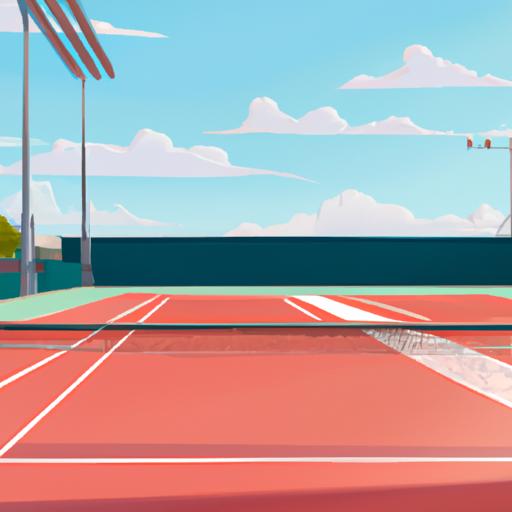Are you looking for the definitive guide on how to fix your tennis court resurfacing? Look no further! In this guide, we will cover step by step the process of fixing your tennis court, from why it is necessary to complete the process, to the right resurfacing material to choose, to preparing the surface and the application of the material.
Whether you are an experienced professional or a beginner, this guide will have all the answers you need to get your tennis court fixed in no time!
Table of Contents
Short Answer
The first step to fix tennis court resurfacing is to remove any cracks, moss, or other debris from the court surface.
Next, use a power washer to clean the court of dirt and grime.
Finally, apply a new coating of acrylic resurfacing material to the court and allow it to dry thoroughly before use.
This will help to ensure the surface is even and ready for play.
Why is Resurfacing Necessary?
Tennis courts are constantly subject to wear and tear due to the daily use of the court.
Over time, the courts surface can become uneven, cracked, and worn down, which can lead to a dangerous playing environment.
Tennis court resurfacing is a necessary process for keeping a court in proper playing condition and providing players with a safe and enjoyable experience.
Regular resurfacing of a court can help to preserve the integrity of the playing surface and extend the life of the court.
Resurfacing a court can also help to improve the playability of the court by providing a better surface for ball control and spin.
Newly resurfaced courts provide players with better grip and traction, which helps them to move more quickly and confidently on the court.
Resurfacing can also help to improve bounce consistency, as a worn-down court can cause the ball to bounce differently in different areas.
In addition to all of these benefits, resurfacing a court can also help to improve the courts appearance.
A court that has been resurfaced looks much better than a court that has not been resurfaced, and can help to create a more inviting environment for players.
Repairing Damaged Areas

When it comes to fixing tennis court resurfacing, the first order of business is to repair any damaged areas.
This might include filling in any cracks, divots, or other imperfections, as well as replacing any loose or broken surfaces.
It is important to repair these problems as quickly as possible in order to prevent further damage and to ensure a safe and enjoyable playing experience.
The repair process will vary depending on the severity of the damage.
For minor issues, such as small cracks or divots, a patching compound can be used to fill in the area and provide a smooth and even surface.
For more severe issues, such as large cracks or broken surfaces, a more comprehensive repair solution will be needed.
In these cases, the issue should be addressed by a professional in order to ensure a safe and effective repair.
Once the damaged areas have been repaired, it is important to thoroughly clean the surface before applying a coat of sealer.
This will help protect the court from further damage and can extend the life of the court.
It is also important to smooth out any remaining uneven areas in order to provide a consistent playing surface.
With the repairs complete and the surface cleaned, a coat of sealer can be applied in order to provide additional protection and to extend the life of the court.
Cleaning the Court
When it comes to fixing tennis court resurfacing, the first step is to thoroughly clean the court.
This can be done with a pressure washer or a broom and dustpan.
It is important to remove any dirt, debris, or other materials that could interfere with the sealant or resurfacing materials.
Additionally, any moss or algae should be removed to reduce the risk of slippery surfaces or damage to the court surface.
After cleaning, the court must be allowed to dry completely before any additional steps can be taken.
Once the court has dried, it is time to apply the sealant.
Applying a Sealer

Once the court has been repaired and cleaned, it is time to apply a sealer.
A sealer is a protective coating that helps keep the court surface in good condition and can also extend its life.
Sealers come in a variety of formulas, including water-based and solvent-based.
It is important to choose the right sealer for your particular court, as some sealers may not be suitable for certain surfaces.
If in doubt, it is best to consult with a professional resurfacing company before beginning the process.
When applying the sealer, make sure to use a roller or sprayer in order to get an even coverage.
Start at the bottom of the court and work your way up in overlapping strokes to ensure an even coat.
It is also important to make sure that the sealer is applied evenly to the sides of the court to prevent water build-up.
Once the sealer is applied, it should be allowed to dry for the recommended time before beginning the resurfacing process.
Choosing the Right Resurfacing Material
When it comes to fixing tennis court resurfacing, it is important to choose the right resurfacing material.
This material will not only provide the necessary traction and cushioning for players, but it will also help extend the life of the court.
The most common materials used for resurfacing a tennis court are acrylic, urethane, and polyurethane.
Each of these materials has its own unique properties that make it suitable for different court surfaces.
Acrylic is the most popular material used for court resurfacing.
It is a hard but flexible material that provides excellent traction and cushioning for players.
Acrylic is also very durable and can withstand wear and tear from heavy use.
Urethane is a softer material that provides a good grip and cushioning, but it may not be as durable as acrylic.
Polyurethane is a very strong and durable material that is often used in commercial tennis courts, but it may not be the best choice for a residential court due to its high cost.
When choosing a resurfacing material, it is important to consider the type of surface that the court is made of.
This will help determine which material will be the most suitable for the court.
It is also important to consider the climate that the court will be exposed to, as some materials may not hold up as well in extreme temperatures.
Always consult with a professional before making a decision.
They will be able to provide guidance on the best material for the court and how to properly install it.
Preparing the Surface

Tennis court resurfacing is an essential part of preserving a courts playing condition.
To ensure a safe and enjoyable experience for players, its important to take the time to properly prepare the playing surface for resurfacing.
The first step is to repair any damaged areas.
This may include filling in cracks or divots, repairing any loose or broken surfaces, and smoothing out any uneven areas.
Once the court is repaired, it should be thoroughly cleaned to remove any dirt, debris, and other contaminants.
This is important to ensure that the resurfacing material adheres properly and provides a durable playing surface.
After the court is cleaned, a coat of sealer should be applied.
The sealer helps protect the court from damage and can extend the life of the court.
It also helps the resurfacing material bond to the courts surface.
Depending on the type of sealer used, multiple coats may be necessary to achieve the desired level of protection.
Once the court is prepared, the appropriate resurfacing material can be applied.
This material should provide the necessary traction and cushioning for players, as well as be durable enough to withstand heavy use.
Depending on the courts condition and the type of material used, multiple coats may be necessary to achieve the desired level of protection.
Its also important to consider the weather when resurfacing a court – certain materials may require specific temperatures or humidity levels in order to properly adhere to the courts surface.
By taking the time to prepare the surface of the court and apply the appropriate resurfacing material, it is possible to fix tennis court resurfacing and ensure a safe and enjoyable playing surface.
Applying the Resurfacing Material
When it comes to fixing tennis court resurfacing, applying the resurfacing material is the final step.
This material is specially designed to provide players with the necessary traction and cushioning when playing.
Depending on the type of court, the materials used may vary for example, clay courts may require a different material than hard courts.
Before applying the material, the court should be cleaned of all debris and dirt.
This will ensure that the material adheres properly and that the court is in the best condition possible before resurfacing.
To apply the material, a roller or brush should be used to spread it evenly across the court.
It is important to use even strokes and to ensure that the material is applied in a uniform manner.
Once the material has been applied, the court should be allowed to dry completely before the next step.
After the court has dried, the surface should be checked for any irregularities that may have occurred during the application process.
If any are found, they should be corrected before the court is ready for use.
Finally, once the court is ready for use, it should be cleaned and maintained regularly to ensure that it remains in good condition.
Taking the time to fix tennis court resurfacing correctly is essential for providing players with a safe and enjoyable playing experience.
Final Thoughts
Tennis court resurfacing is a necessary process for maintaining a court in good condition and providing a safe and enjoyable playing experience.
With the right knowledge and preparation, resurfacing a court can be a relatively easy process.
From repairing any damaged areas to applying the perfect resurfacing material, this guide has provided all the steps needed to properly resurface a court.
Now that you have the tools and knowledge to fix tennis court resurfacing, it’s time to take action!

